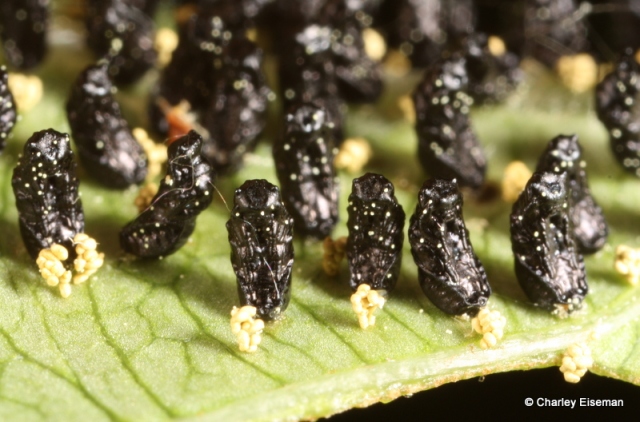It’s getting hard to do anything in the yard without bumping into another new leafminer or sawfly to document.
#49: Nemorimyza posticata (Agromyzidae). I found several mines of this species on Canada goldenrod (Asteraceae: Solidago canadensis) around the house yesterday and today.

Sort of an ugly brown smear of a mine when viewed in reflected light, but check out the backlit version:

I don’t know about you, but I always get a kick out of seeing the pattern of “toothmarks” in leaf mines of Nemorimyza posticata, which can be found on a wide variety of Asteraceae. Here’s a closer look:

The larva will exit to pupate shortly, emerging as an adult in a few weeks. If it’s a male, it will have a distinctive white-tipped abdomen. Here’s one that was kind enough to pose with his empty puparium:

#50: Scrobipalpula nr. diffluella (Gelechiidae). This was one of the first leafminers I ever found in my yard, in the first daisy fleabane plant (Asteraceae: Erigeron annuus) that popped up after we moved in. I found just a single mine on September 27, 2013, and the adult emerged on halloween; I don’t think I had seen another one since, until I found two on a single plant along my driveway yesterday.


The larva forms a full-depth mine along the midrib, keeping it nice and clean by dumping all of its frass in a neat little pile just outside the basal end.

This species is part of a confusing complex that I don’t expect will get sorted out in my lifetime, but for what it’s worth, the adult looks like this:
#51: Parectopa plantaginisella (Gracillariidae). Another species whose mine I found on that first daisy fleabane plant seven years ago. The mine starts as an epidermal track on the lower surface, later becoming a puffy, greenish blotch.


One of the adults from 2013:
#52: Metallus lanceolatus (Tenthredinidae)—also sawfly larva #12 for the season. This is an introduced European species that feeds on Geum spp. (Rosaceae), in this case white avens (G. canadense).

This species is unusual among leaf-mining sawflies in having multiple generations per year. Larvae can be found from May to October.

Not related to leafminers or sawflies, but worth mentioning anyway, is this cluster of Eulophus (Eulophidae) pupae I noticed on the underside of a leaf next to the upper vegetable garden:

These have been called “tombstone pupae” because they mark the spot where a caterpillar met its end. The eulophid larvae fed as ectoparasitoids on the caterpillar until it died, then dismounted, deposited in neat little piles the yellow poop they’d been saving up their whole lives, and then molted to black pupae, sitting upright like tombstones.

It’s hard to get good macro photos right now because everything is covered with little pollen grains.
Remember the Orchestes pallicornis female that was laying eggs in the midrib of a black cherry leaf back in part 8?

I’ve been keeping an eye on that leaf, which has become severely disfigured as it expanded, the egg scars stretching into large holes:


This evidently happened before most of the eggs hatched, thus dooming them, but the one closest to the tip of the leaf survived and the mine was first noticeable yesterday—visible in the second photo above and in the backlit photo below.

Leafminer #53, and sawfly #13: Fenusa pumila (Tenthredinidae). This is one of five European birch-feeding leaf-mining sawflies that have been introduced in North America. The mines of multiple larvae coalesce into one big blotch, as in this paper birch leaf (Betulaceae: Betula papyrifera) at the edge of my yard:


Leaf-mining sawfly larvae feed belly-up, so the black ventral plates of this species are visible from above.

Leafminer #54: Phytomyza aralivora (Agromyzidae). I swear I had been checking the wild sarsaparilla patch (Araliaceae: Aralia nudicaulis) behind the shed every day for these mines, and I never saw any until yesterday, when suddenly there were about twenty that were all already vacated.

(Too bad I didn’t notice that psyllid nymph at the time; it would have been nice to get a close-up of it.)
These leaf mines are a common sight across northern North America, but apart from the adults I’ve reared in Massachusetts the only known specimens are from Alberta and Montana.

I got a nice series of one emerging from its puparium a few years ago, but no time to post it all right now… here are two photos to give you some idea; also see my post on balloon-faced flies.


Yesterday’s last finds were both on a smooth shadbush (Rosaceae: Amelanchier laevis) that we planted in the backyard meadow last fall. Both can be seen on this leaf:

Leafminer #55: Parornix sp. (Gracillariidae). The brown patch to the left in the photo above is the upper surface of an underside tentiform mine. Here’s the lower surface:

At this point I couldn’t say which Parornix species this is, but it’s safe to say it’s a different one from the one I found mining a paper birch leaf the other day.
The smooth shadbush plant also had five larvae of sawfly #14; I have no idea what species they are, but they “window-feed” in little patches in a way that made me think they were pear slugs (Caliroa cerasi) until I had a closer look.


As for today’s finds… I think those will have to wait until tomorrow!





Pingback: The Yard List(s), Part 16 | BugTracks
Pingback: The Yard List(s), Part 17 | BugTracks
Pingback: The Yard List(s), Part 20 | BugTracks